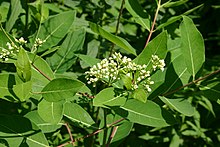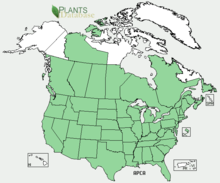Apocynum cannabinum: Difference between revisions
m http→https for Google Books and Google News using AWB |
Rescuing 1 sources and tagging 0 as dead. #IABot (v1.2.5) |
||
| Line 119: | Line 119: | ||
==External links== |
==External links== |
||
*[http://www.itis.usda.gov/servlet/SingleRpt/SingleRpt?search_topic=TSN&search_value=30157 USDA: ''Apocynum cannabinum'' (Indianhemp)] |
*[https://web.archive.org/web/20041106151229/http://www.itis.usda.gov/servlet/SingleRpt/SingleRpt?search_topic=TSN&search_value=30157 USDA: ''Apocynum cannabinum'' (Indianhemp)] |
||
*[http://www.calflora.org/cgi-bin/species_query.cgi?where-taxon=Apocynum+cannabinum Calflora Database: ''Apocynum cannabinum'' (Indian hemp, Indianhemp dogbane)] |
*[http://www.calflora.org/cgi-bin/species_query.cgi?where-taxon=Apocynum+cannabinum Calflora Database: ''Apocynum cannabinum'' (Indian hemp, Indianhemp dogbane)] |
||
*[http://ucjeps.berkeley.edu/cgi-bin/get_JM_treatment.pl?Apocynum+cannabinum Jepson Manual Treatment - ''''Apocynum cannabinum''''] |
*[http://ucjeps.berkeley.edu/cgi-bin/get_JM_treatment.pl?Apocynum+cannabinum Jepson Manual Treatment - ''''Apocynum cannabinum''''] |
||
Revision as of 11:43, 16 October 2016
| Apocynum cannabinum | |
|---|---|

| |
| Apocynum cannabinum in flower | |
| Scientific classification | |
| Kingdom: | |
| (unranked): | |
| (unranked): | |
| (unranked): | |
| Order: | |
| Family: | |
| Genus: | |
| Species: | A. cannabinum
|
| Binomial name | |
| Apocynum cannabinum | |

| |
| Natural range in North America | |
| Synonyms[1] | |
|
List
| |
Apocynum cannabinum (Dogbane, Amy Root, Hemp Dogbane, Prairie Dogbane, Indian Hemp, Rheumatism Root, or Wild Cotton)[2] is a perennial herbaceous plant that grows throughout much of North America - in the southern half of Canada and throughout the United States.[1][3] It is a poisonous plant: Apocynum means "poisonous to dogs". All parts of the plant are poisonous and can cause cardiac arrest if ingested. The cannabinum in the scientific name and the common names Hemp Dogbane and Indian Hemp refer to its similarity to Cannabis as a fiber plant (see Hemp), rather than as a source of a psychoactive drug (see Cannabis (drug))
Although dogbane is poisonous to livestock, it likely got its name from its resemblance to a European species of the same name.[4]
Distribution and habitat
Apocynum cannabinum grows in open wooded areas, ditches, and hillsides. It is found in gravelly or sandy soil, mainly near streams in shady or moist places.[5]
Description
Apocynum cannabinum grows up to 2 meters/6 feet tall. The stems are reddish and contain a milky latex capable of causing skin blisters. The leaves are opposite, simple broad lanceolate, 7–15 cm long and 3–5 cm broad, entire, and smooth on top with white hairs on the underside. It flowers from July to August, has large sepals, and a five-lobed white corolla. The flowers are hermaphrodite (have both male and female organs) and are pollinated by moths and butterflies.[5]
Invasive species
In gardens it can be invasive, growing from spreading roots. When growing among corn, Apocynum cannabinum can reduce yields by up to 10% and when growing among soybeans, by up to 40%. It can be controlled through mechanical means, although it is difficult to control with herbicides.
Uses
The plant can be used for various purposes. The most used parts are the seeds, the root and the bark.
Fiber
A very strong and good quality fiber obtained from the bark is a flax substitute that does not shrink and retains its strength in water.[5] It is used for making clothes, twine, bags, linen, paper, etc.[5] The plant yields a latex which is a possible source of rubber.[5] Apocynum cannabinum was used as a source of fiber by Native Americans,[6] to make hunting nets, fishing lines, clothing, and twine.[4] It is called qéemu [qǽːmu] in Nez Perce and [taxʷɨ́s] in Sahaptin. The Concow tribe call the plant pö (Konkow language).[7]
String and cordage
In the fall, when toxins drain to the roots, the plant can be harvested for fiber, which can be used to make strong string and cordage for use in bows, fire-bows, nets and tie down straps.
Food
The seeds have an edible use as a meal (raw or cooked) when ground into a powder.[5]
Chewing gum
After the latex has been squeezed from the plant, it is allowed to stand overnight to harden into a white gum which can be used (sometimes mixed with clean clay) as chewing gum.[5]
Phytoremediation
Apocynum cannabinum is a phytoremediation plant, a hyperaccumulator used to sequester lead in its biomass.[citation needed] [jargon]
Medicinal
It is also used in herbal medicine to treat fever,[citation needed] and dysentery.[citation needed] Although the toxins from the plant can cause nausea and catharsis[dubious – discuss], it has also been used for slowing the pulse,[citation needed] and it is also a sedative[citation needed] and mild hypnotic.[citation needed] It is an unpleasantly bitter stimulant irritant herb that acts on the heart, respiratory and urinary systems, and also on the uterus. Apocynum cannabinum was much employed by various Native American tribes who used it to treat a wide variety of complaints including rheumatism, coughs, pox, whooping cough, asthma, internal parasites, diarrhoea and also to increase milk flow in lactating mothers.[5] The root has been used as a tonic, cardiotonic, diaphoretic, diuretic, emetic (induces vomitting) and expectorant.[5] It is harvested in the autumn and dried for later use. The fresh root is the most active part medicinally.[5] A weak tea made from the dried root has been used for cardiac diseases and also as a vermifuge (an agent that expels parasitic worms).[5] The milky sap is a (presumably topically applied) folk remedy for venereal warts.[5] The plant is still used in modern herbalism, though it should be used with great caution and only under the supervision of a qualified practitioner if taken internally.
See also
References
- ^ a b "The Plant List: A Working List of All Plant Species". Retrieved June 18, 2014.
- ^ Apocynum cannabinum, ITIS report
- ^ Biota of North America Program 2013 county distribution map
- ^ a b Heiser, C. B. (2003). Weeds in my Garden: Observations on some Misunderstood Plants. Portland, OR: Timber Press. p. 50. ISBN 0-88192-562-4.
- ^ a b c d e f g h i j k l "Apocynum cannabinum Indian Hemp PFAF Plant Database". Retrieved Jan 4, 2015.
- ^ Coville, F. V. (1897). "Notes On The Plants Used By The Klamath Indians Of Oregon" (pdf). Contributions from the U.S. National Herbarium. 5 (2): 87–108 (p. 103).
- ^ Chesnut, V. K. (1902). "Plants used by the Indians of Mendocino County, California". Contributions from the U.S. National Herbarium. 7 (3): 295–408 (p. 407). LCCN 08010527.
- Blanchan, Neltje (2002). Wild Flowers: An Aid to Knowledge of our Wild Flowers and their Insect Visitors. Project Gutenberg Literary Archive Foundation.
- A. Davis, K. Renner, C. Sprague, L. Dyer, D. Mutch (2005). Integrated Weed Management. MSU.
External links
- NatureServe secure species
- Apocynaceae
- Poisonous plants
- Flora of Canada
- Flora of the Eastern United States
- Flora of the Western United States
- Flora of Northeastern Mexico
- Flora of California
- Flora of the Cascade Range
- Flora of the Rocky Mountains
- Flora of the Sierra Nevada (U.S.)
- Natural history of the California chaparral and woodlands
- Plants described in 1753
- Taxa named by Carl Linnaeus
- Fiber plants
- Butterfly food plants
- Phytoremediation plants
- Plants used in traditional Native American medicine

